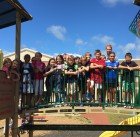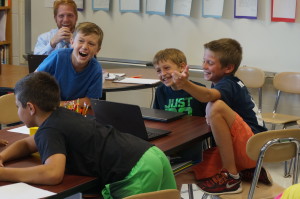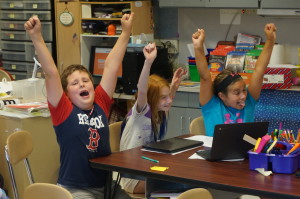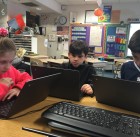Viewing: Chromebooks
August 28, 2015

Happy Friday!
 We have started off the year with three terrific days in room 209! The start of school can be a challenging transition for students, and Mr. Walmer and I have worked hard to make our classroom a welcoming community for all 22 new fourth graders. Of course, we did the usual activities with learning classroom routines, students attended their first music, library, Spanish, and wellness classes, and we participated in our school’s traditional first day bell-ringing ceremony. I’d like to take the opportunity to share with you four other activities we’ve been working on this week.
We have started off the year with three terrific days in room 209! The start of school can be a challenging transition for students, and Mr. Walmer and I have worked hard to make our classroom a welcoming community for all 22 new fourth graders. Of course, we did the usual activities with learning classroom routines, students attended their first music, library, Spanish, and wellness classes, and we participated in our school’s traditional first day bell-ringing ceremony. I’d like to take the opportunity to share with you four other activities we’ve been working on this week.
Social Contract
In lieu of class rules, we have worked together to brainstorm ways we want to be treated. Specifically, students answered four questions:
- How do we want to be treated by our teachers?
- How do our teachers want to be treated by us?
- How do we want to treat each other?
- How do we want to treat each other when there is a conflict?
In answering these questions, students generated lists of ideas that describe how we should treat others in the classroom. Some words/phrases, such as “respectfully” and “fairly” appeared as answers to multiple questions, so these will likely be emphasized in our final social contract (which I hope to finish early next week). The social contract is a terrific resource, because we all hold one another accountable to fulfill what we agree to do (when we all sign it.) So if a student is, for example, disturbing others during a lesson, I can refer back to the social contract by saying something like “Hey, Timmy, when you signed the social contract, you agreed to be helpful. When you’re making funny faces, are you helping your classmates to learn? You also promised to be respectful to others. I’ve asked you a few times to focus on the lesson, and I noticed that your friend asked you not to distract her as well. Are you respecting your friend and me when you keep doing that?” Using the social contract helps students to adjust their choices and see why poor choices affect others negatively, rather than just “getting in trouble.”
Chromebooks and Google Classroom
I love using technology in our classroom when it allows students to interact or think at a deeper level, when it makes some of our classroom processes more efficient, or when it is a motivator to students. Yesterday, students got their first opportunity of the year to work on Chromebooks and to log into our Google Classroom page. Kids completed an exercise to prepare for our Two Truths and a Lie activity (see below), and today, students started writing letters to their future selves (at the end of this year) about their goals, predictions, worries, and hopes for the year to come. I’ll share a lot more information with you in the coming weeks, but in the interest of clarity please note that (a) students should always share their Google login information with their grownups at home, and (b) students should NOT be using their school Google email accounts at all right now.
Two Truths and a Lie
Yesterday, students wrote th ree statements about themselves in a Google Doc activity; two of the statements were true, and one was a lie. Last night, I imported those statements into a game environment called Kahoot, which creates a quiz game based on the content I import. We played this game this afternoon, and the kids really
ree statements about themselves in a Google Doc activity; two of the statements were true, and one was a lie. Last night, I imported those statements into a game environment called Kahoot, which creates a quiz game based on the content I import. We played this game this afternoon, and the kids really  enjoyed learning more about their classmates in a fun and unique way! Plus, the gameshow-like interface of Kahoot created a friendly competition in our classroom. We’ll definitely use this tool more in the future!
enjoyed learning more about their classmates in a fun and unique way! Plus, the gameshow-like interface of Kahoot created a friendly competition in our classroom. We’ll definitely use this tool more in the future!
Readers’ Workshop
Reading lessons started on Thursday! In fourth grade, our reading instruction is inspired by Readers’ Workshop, which is an instructional philosophy that the best literacy instruction is delivered in small bundles, with plenty of opportunity to practice skills as a whole class, in small groups, and individually. Our lessons started with an introduction to our classroom library and book bins, and continued today with a lesson about what silent reading should look like and sound like.
Alliterative Adjective Greetings
You may have noticed that your son or daughter came home on Wednesday with an assignment to think of an adjective that either starts with the same letter as his or her first name and/or with the same sound as his or her first name. Today, students greeted their classmates at their table groups with their nicknames, and we added some challenge by asking students to race to pass around a foam ball while greeting their table-mates, sometimes while skipping around!
Posted in Class Updates|By Jon Moss
January 20, 2015

Respect for all races, religions, and cultures
This is my favorite time of the school year, not because of the beautiful weather (yuck) but because of the terrific units we are starting in class. Our class recently read a book called As Good As Anybody, which tells the stories of Martin Luther King, Jr. and Abraham Joshua Heschel – two men who had very different lives but experienced very similar adversities, and who ended up working together to make our world a better place. We always start this a week or two before Martin Luther King, Jr. Day, and it gives us a terrific opportunity to explore the wonderful contributions that Dr. King made to our society. As a class, students identified ways in which the two gentlemen were similar and different, and they used that comparison document to write short answer responses (in small groups) comparing and contrasting the men. This gave students the background so that they could write their own responses to a similar story, The Other Side, independently.
All the kids were familiar with Martin Luther King, Jr, but none of them knew who Abraham Joshua Heschel was. (At that age, I didn’t either.) He grew up in Europe and was a persecuted Jew during the beginning of the Holocaust. He fled to the United States and, along with Dr. King, he worked to promote a world in which everyone was treated with respect and dignity. Although the kids don’t yet know this, our study of As Good As Anybody launched our study of the Holocaust, which will really kick-off next week, as we begin work with the outstanding novel Number the Stars. In the coming days and weeks, you’ll hear much more from me about this unit. Some parents understandably are concerned about their children being taught things that are frightening or upsetting. Rather than focusing on the disturbing events that took place during this infamous time in history, we instead focus on the feelings and attitudes of people – the persecuted Jews, those who secretly supported the Jews at their own risk, those who did the persecuting, etc. We steer clear of the graphic details. As I said, stay tuned for more information coming your way soon.
Have a great week!
Posted in Class Updates|By Jon Moss
November 5, 2014
New Student Email Accounts and Chromebooks
![]() Today, students were excited (to put it mildly) to receive their own Avon Public Schools email addresses. We set them up as a class, and students sent test emails to me and to their classmates. These email addresses also enable Google Drive, which will allow for students to collaborate in and out of school on assignments, in addition to making some of our online homework assignments more secure. Students definitely haven’t learned everything, however. Over the next few weeks (months, really), we will learn more about how to use email, Google Drive, Chromebooks, and much more!
Today, students were excited (to put it mildly) to receive their own Avon Public Schools email addresses. We set them up as a class, and students sent test emails to me and to their classmates. These email addresses also enable Google Drive, which will allow for students to collaborate in and out of school on assignments, in addition to making some of our online homework assignments more secure. Students definitely haven’t learned everything, however. Over the next few weeks (months, really), we will learn more about how to use email, Google Drive, Chromebooks, and much more!
Students have their log in information written on post-it notes in their planners. (Plus, if your child has difficulty logging in, I have copies of their usernames and passwords and can help out over the weekend.
We spent a significant amount of time discussing proper email behavior. While we talked a lot about the SERIOUS, MAJOR topics, such as cyber bullying, internet safety, and the permanency of online communications, we also discussed email etiquette. We spoke about how to appropriately use the subject line, choosing how to include recipients, and more. As kids continue to use their new accounts, I will certainly continue to take advantage of teachable moments to extend these skills. Remember, using email isn’t just a technical know-how skill. It also includes new social norms, pragmatics, and problem-solving skills.
Here are a few things you might want to know about the email accounts and how I am managing them:
- As discussed in the Responsible Usage Agreement that students and parents signed in the fall, email accounts are being distributed to students in Avon Schools starting in gr. 4.
- Students can only send email to and receive email from other avon.k12.ct.us email accounts. (So you cannot email your fourth grader, nor can they email you. This is for privacy and safety reasons.)
- All emails (and other electronic communications within the Google system) are archived pursuant to federal law.
- I do have usernames and passwords for all student email accounts. (I told students this in advance of them choosing their passwords since I know some students may have preferred passwords that they use for many things but might not want to share with me.)
- I told students that they MUST share their username and password with their parents. (If they don’t, email me and I’ll share it.) No secrets here!
- When composing new messages within a web browser, it’s easy to send an email to another APS individual with the same first or last name that the user has started to type. It’s important to carefully select the RIGHT recipients.
- I take any sort of online teasing (up to and including cyber-bullying) very seriously. Kids, don’t test me on this.
- Kids may not set up their APS email accounts on any home device (such as an iPad) without parental permission. (Although some kids have their own devices, some parents may prefer that online communication stays on a family computer so they can supervise. That’s why I made this rule.) If parents are ok with this, then be my guest!
- Some teachers have prohibited non-school-related emails between students. I haven’t, because I think that social emailing is a good way to learn the “ins and outs” of email use and etiquette. We discussed how quickly social emails can become “spam” and an irritation to others. Students have been told that it’s up to their PARENTS to decide whether they can socially email classmates outside of school. Friendly emails are fine with me, but excessive social emailing can become an issue. Again, this is not something that kids have an innate understanding of, so we will need to teach these skills on an ongoing basis. (That’s why I don’t ban social emailing – so we can TEACH it, not just prohibit it.)
- Students are welcome to email me when they have questions or concerns. In the past, I’ve always CC’ed parents when I reply to students. But since you will have their usernames and passwords, I may not continue to do so. I explained to kids that there is one of me and 22 of them, so if I get inundated with emails, I will reply to urgent emails more quickly than to social emails.
Posted in Class Updates|By Jon Moss
